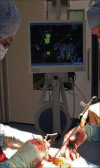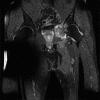Navigation in Musculoskeletal Oncology: An Overview
- PMID: 29416166
- PMCID: PMC5791227
- DOI: 10.4103/ortho.IJOrtho_205_17
Navigation in Musculoskeletal Oncology: An Overview
Abstract
Navigation in surgery has increasingly become more commonplace. The use of this technological advancement has enabled ever more complex and detailed surgery to be performed to the benefit of surgeons and patients alike. This is particularly so when applying the use of navigation within the field of orthopedic oncology. The developments in computer processing power coupled with the improvements in scanning technologies have permitted the incorporation of navigational procedures into day-to-day practice. A comprehensive search of PubMed using the search terms "navigation", "orthopaedic" and "oncology" yielded 97 results. After filtering for English language papers, excluding spinal surgery and review articles, this resulted in 38 clinical studies and case reports. These were analyzed in detail by the authors (GM and JS) and the most relevant papers reviewed. We have sought to provide an overview of the main types of navigation systems currently available within orthopedic oncology and to assess some of the evidence behind its use.
Keywords: Computer-assisted tumor surgery; Tumors; computer assisted decision making; magnetic resonance imaging; musculoskeletal tumors; navigation; pelvis.
Conflict of interest statement
There are no conflicts of interest.
Figures














References
-
- Seide K, Faschingbauer M, Wenzl ME, Weinrich N, Juergens C. A hexapod robot external fixator for computer assisted fracture reduction and deformity correction. Int J Med Robot. 2004;1:64–9. - PubMed
-
- Krettek C, Geerling J, Bastian L, Citak M, Rücker F, Kendoff D, et al. Computer aided tumor resection in the pelvis. Injury. 2004;35(Suppl 1) S-A79-83. - PubMed
-
- Hufner T, Kfuri M, Galanski M, Bastian L, Loss MM, Pohlemann TM, et al. New indications for computer assisted surgery: Tumour resection in the pelvis. Clin Orthop Relat Res. 2004;426:219–25. - PubMed
-
- Maldjian JA, Schulder M, Liu WC, Mun IK, Hirschorn D, Murthy R, et al. Intraoperative functional MRI using a real-time neurosurgical navigation system. J Comput Assist Tomogr. 1997;21:910–2. - PubMed
-
- Kosugi Y, Watanabe E, Goto J, Watanabe T, Yoshimoto S, Takakura K, et al. An articulated neurosurgical navigation system using MRI and CT images. IEEE Trans Biomed Eng. 1988;35:147–52. - PubMed
LinkOut - more resources
Full Text Sources
Other Literature Sources
